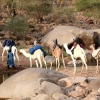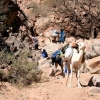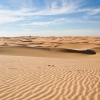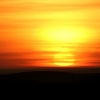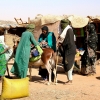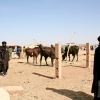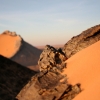Niger – The Massif between Deserts
(2005)
The Aïr Mountains (also known as the Aïr Massif) is a triangularmassif, located in northern Niger, within the Sahara desert. Part of the West Saharan montane xeric woodlands ecoregion, they rise to more than 1,800 m and extend over 84,000 km2 . Lying in the midst of desert north of the 17th parallel, the Aïr plateau, with an average altitude between 500 and 900 m, forms an island of Sahel climate which supports a wide variety of life (Dorcasgazelle), many pastoral and farming communities, and dramatic geological and archaeological sites. There are notable archaeological excavations in the region that illustrate the prehistoric past of this region. The endangered Painted Hunting Dog, Lycaon pictus once existed in this region, but may now be extirpated due to human population pressures in this region.
The Aïr mountains themselves consist of nine almost circular massifs rising from a rocky plateau, bordered by the sand dunes (up to 400 m) and plain of the Ténéré Desert to the east. The massif contains volcanic features including the extinct caldera of Arakao. At Izouzaoenehe, lie the marble Blue Mountains, and the lower Zagado valley is surrounded by white marble hills.
The northern Air Massif and north eastern part of the Ténéré are since 1991 part of UNESCO World heritage.
Das Aïr ist ein Hochgebirge im zentralen Niger. Es besteht aus einer Kette von Bergen, die sich in Nord-Süd-Richtung bis zu 1500 Meter aus der östlich gelegenen Sandwüste Ténéré erheben. Höchster Berg ist mit 2022 m der im südlichen Teil gelegene Idoukal-n-Taghès (auch Mont Bagzane genannt). Der Nordostwind weht im Schatten der Berge den Sand zu bis zu 400 m hohen Dünen auf. Vor allem auf der Westseite zerklüften zahlreiche Wadis die Berge.
Der nördliche Teil des Aïr-Gebirge gehört zusammen mit dem nordöstlichen Abschnitt der Wüste Ténéré seit 1991 zum Weltnaturerbe der UNESCO. Das Aïr und Ténéré Naturreservat ist mit 77.000 km² das größte Schutzgebiet Afrikas.
Die Bergregion bildet eine Sahel-Enklave mitten in der Sahara und den nördlichsten Punkt, in dem nach Durchqueren der Wüste in größerem Umfang Vegetation anzutreffen ist. Auf Grund der abgelegenen Lage finden sich dort auch die Wildformen einer Reihe wichtiger Kulturpflanzen, etwa wilde Oliven, Perlhirse und Sorghum. Die Tierwelt ist mit 40 Säugetier-, 165 Vögel- und 18 Reptilienarten vielfältig. Ende der 1980er Jahre wurden fünf gefährdete Tierarten beobachtet: Dama- und Dorkasgazelle, Mähnenspringer,Mendesantilope und Afrikanischer Strauß. Durch die Jagd sind sie massiv in ihrem Bestand bedroht.
Im Süden des Gebirges liegt der für die Paläoarchäologie bedeutende Ausgrabungsgebiet Gadoufaqua, der sogenannte Saurierfriedhof der Sahara.






